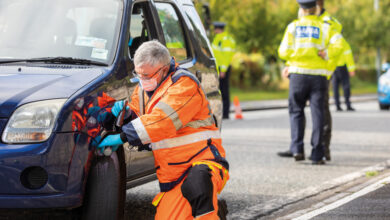Minister of State Hildegarde Naughton TD: Road Safety Strategy 2021–2030

Ireland has made enormous progress in recent years in addressing the appalling death and serious injury toll on our roads, writes Hildegarde Naughton TD, Minister of State in the Department of Transport with responsibility for road safety.
In 1997, the year before our first Road Safety Strategy was published, a staggering 472 people died on our roads. In 2021, the number fell to the lowest since records began.
But this is not a reason for complacency. How we move people and goods around has changed and will change in even more profound ways over the coming years. New modes of transport which did not exist a few short years ago, such as eBikes and eScooters, are common sights in our villages, towns and cities, and the number of people walking, and cycling is also on the rise.
And it is for that reason that at the heart of the Government’s Road Safety Strategy 2021-2030 is change, and a recognition that our attitudes and behaviours must change to take account of the fact that no one form of transport takes primacy over another.
The strategy includes a key focus on vulnerable road users, particularly cyclists and pedestrians. And as part of this change, we must all accept and realise that every road user is entitled to use our roads and not have their life or safety put at risk due to the dangerous behaviour of others.
The primary aim of the strategy is to reduce the number of deaths and serious injuries on Irish roads by 50 per cent over the next 10 years. What does that mean in practice? It means reducing deaths from 144 per year to 72, or lower, and reducing serious injuries from 1,259 to 630, or lower, by 2030. It will also be the first step in Ireland’s journey towards realising Vision Zero, i.e., no deaths or serious injuries by 2050.
These are ambitious targets, but they have been developed on the basis that the vast majority of road users have made superb efforts to make our roads safer. As previously mentioned, we have had multiannual Road Safety Strategies since 1998. From 472 deaths in 1997, in 2020 we had 146 deaths on our roads and last year, 2021, there were 136.
We can build on this progress by drawing on the wealth of data and analysis around driver behaviour, road condition, and other factors which helps us understand how and where collisions occur. We know that speed is a major factor in collisions, but thankfully most road users know that the speed limit is not a target to be reached. We know that alcohol and drugs are high risk factors, but the vast bulk of drivers know never to drink and drive and drink driving is no longer seen – if it ever was – as being socially acceptable.
We also know that more effort is required in some areas. Too many people die for lack for putting on their seat belt. Too many people are distracted by their mobile phone. And unfortunately, too many people die in collisions where fatigue is a factor.
The new strategy meets the objectives in the 2020 Programme for Government to work on implementing the Vision Zero principle which is the global movement to eliminate road deaths by 2050, and to focus on reducing death and injuries of vulnerable road users.
The strategy has been developed using a collaborative approach, led by the Road Safety Authority which has examined international best practice, and conducted a national public consultation and in-depth stakeholder consultation.
“The new strategy meets the objectives in the 2020 Programme for Government to work on implementing the Vision Zero principle which is the global movement to eliminate road deaths by 2050, and to focus on reducing death and injuries of vulnerable road users.”
Minister of State in the Department of Transport Hildegarde Naughton TD
The Strategy also took into account feedback from both Minister Eamon Ryan TD and I, as well as closely working with key stakeholders such as the departments of transport and justice, the Road Safety Authority, An Garda Síochána, the Medical Bureau of Road Safety, Transport Infrastructure Ireland, our local authorities, and other agencies.
This Strategy adopts the holistic Safe System approach to road safety management, which is recognised as best practice by the EU, UN, and the World Health Organisation. The Safe System approach recognises that human error and human frailty must be accommodated in our road traffic system. It also emphasises that there is a shared responsibility for road safety across all parts of this system, from road users themselves, to how our roads and vehicles are designed, to how we provide emergency care for those involved in collisions. All parts of the system must work together to reduce deaths and injuries.
This strategy covers a longer period than previous road safety strategies, to align the end date with EU, UN, and WHO road safety plans. Our new strategy is divided into three phases running from 2021–2024, 2025–2027 and 2028–2030. There will be an action plan for each phase, which take into account emerging trends and the most recent road safety developments and innovations. This will ensure the strategy continuously incorporates the most appropriate, effective actions to reach our goal.
The first phase, which runs until 2024, targets a 15 per cent reduction in deaths and a 10 per cent drop in serious injuries. It is backed by some €3.8 billion of investment. Among the key actions to be progressed in this period include:
- a review of speed limits, particularly considering a 30km/h default speed limit in urban areas;
an expansion of speed management measures using period speed limits at schools; - exploring the potential of developing an online portal for road users to upload footage of road traffic offences which could assist in prosecution; and
- a review of penalties for serious road traffic offences including impaired driving, non-wearing of seat belts, and carrying children in vehicles without the appropriate safety restraints.
These actions will be carried out in tandem with other measures, such as investment in our roads infrastructure and walking and cycling facilities, and a review of road traffic policy and legislation to prioritise walking and cycling safety.
In order to deliver this ambitious strategy, a cross-government governance structure has been designed which will be overseen by a Ministerial Committee on Road Safety which I co-chair with the Minister for Justice, Helen McEntee TD.
This strategy is ambitious, but it is achievable. We have already demonstrated our ability to make our roads safer, and this strategy builds on progress made to date. Working together, I know we can achieve our targets for 2030, and lay the foundations to achieve Vision Zero in Ireland by 2050. I look forward to achieving Ireland’s safest decade on the roads by 2030, and a safer, healthier Ireland for all.





